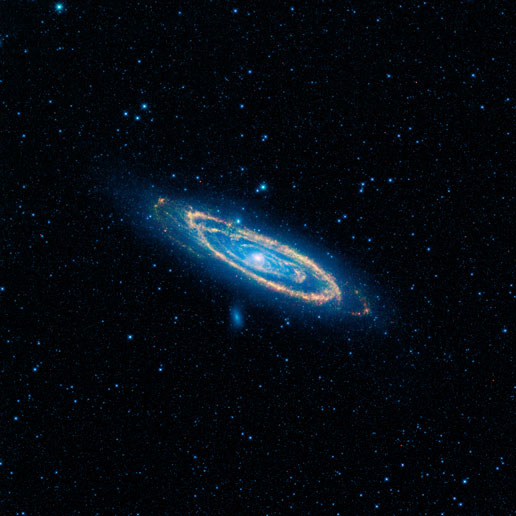Science News
Black Hole Bonanza
June 21, 2013
by Alyssa Keimach

Astronomers often describe Andromeda as a “sister galaxy” to our own Milky Way. It is relatively nearby, similarly sized, and comparably shaped. So what does it mean when we confirm that Andromeda is host to a “black hole bonanza”?
A black hole is born when a massive star collapses, resulting in a high concentration of gravity, so strong that light cannot even escape its pull. By definition, we can’t observe black holes directly, but astronomers can detect them if a close-orbiting star is pulled inside. Gravitational forces compress the star’s material, producing high-energy radiation in the process.
NASA’s Chandra X-ray observatory followed the radiation trail to identify 26 new black hole candidates, the largest number found outside of the Milky Way to date. Follow-up observations by the European Space Agency’s XMM-Newton X-ray observatory gave information useful for determining the nature of these black holes.
The first step in classifying Chandra’s findings: confirm the black hole sizes and locations. The process relies on perspective. In the same way a tall person standing far away can appear the same size as a short person much closer, objects in space can deceive us with their apparent size, so we need to look for additional clues. In the case of black holes, researchers saw bright and fast variability of X-ray emission to determine these 26 black holes are smaller “stellar mass” systems within Andromeda rather than supermassive black holes behind Andromeda.
As it turns out, neutron stars can look a lot like black holes from a distance, so researchers analyzed x-ray brightness and color. Neutron stars also emit x-ray radiation, but a black hole appears brighter—and a different color.
Eight of the black holes reside in globular clusters, concentrations of stars spherically distributed about the center of a galaxy that exist in both the Milky Way and Andromeda. However, astronomers have not yet discovered black holes in any of the Milky Way’s globular clusters.
“When it comes to finding black holes in the central region of a galaxy, it is indeed the case where bigger is better,” said co-author Stephen Murray of Johns Hopkins University and the Harvard-Smithsonian Center for Astrophysics (CfA). “In the case of Andromeda, we have a bigger bulge and a bigger supermassive black hole than in the Milky Way, so we expect more smaller black holes are made there as well.”
Perhaps the two galaxies aren’t as sisterly as we thought. The central bulge of Andromeda is larger, which explains why seven of the new candidates exist within 1,000 light years of Andromeda’s core.
Considering that we can only detect black holes when they are producing high-energy radiation, there must be more that we have not found yet—in both galaxies. Lead author Robin Barnard of CfA states, “While we are excited to find so many black holes in Andromeda, we think it’s just the tip of the iceberg, most black holes won’t have close companions and will be invisible to us.”
Alyssa Keimach is an astronomy and astrophysics student at the University of Michigan and interns for the Morrison Planetarium.
Image: NASA/JPL-Caltech/UCLA